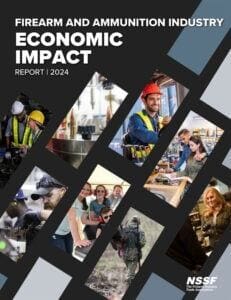The total economic impact of the firearm and ammunition industry in the United States increased from $19.1 billion in 2008 to $90.05 billion in 2023, a 371 percent increase, while the total number of full-time equivalent jobs rose from approximately 166,000 to over 384,437, a 131 percent increase in that period, according to a report released by the NSSF.
On a year-over-year basis, the industry’s economic impact rose from $80.73 billion in 2022, to $90.05 billion in 2023. The firearm industry has broader impacts throughout the economy. It supports and generates business for firms seemingly unrelated to firearms, at a time when every job in America counts. These are real people, with real jobs, working in industries as varied as banking, retail, accounting, metal working and printing among others.

The firearm and ammunition industry paid more than $10.90 billion in business taxes, including property, income and sales-based levies. An additional $944 million was paid in federal excise taxes, which directly contributes to wildlife conservation.
“Our industry is a vital economic contributor to every state and every community. These are companies employing men and women from all walks of life and they prove daily that the American firearm and ammunition industry is strong,” said Joe Bartozzi, NSSF President and CEO. “This industry proudly provides the means for law-abiding citizens to exercise their Second Amendment rights, enables them to hunt and is the primary fiscal force behind wildlife conservation in America. The growth of the firearm industry equals more jobs that add to our local economies, averaging $67,500 in wages and benefits, up from $65,000 reported last year. Since 2008, federal business tax payments increased by 353 percent, Pittman-Robertson excise taxes on firearms and ammunition that support wildlife conservation by 168 percent and state business taxes by 215 percent.”
The annual Firearm and Ammunition Industry Economic Impact Report provides a state-by-state breakdown of job numbers, wages and output covering direct, supplier and induced employment, as well as federal excise taxes paid. Access the full report here.





and those jobs head to areas where they’re needed, as the manufacturers leave the traditional spots.
I hate it whenever I hear the NSSF bragging about how much money was wrongly stolen from gun buyers under the Pittman-Robertson act tax.
Wildlife conservation is great, but we are taxed every which way from Sunday and the tax money is never enough for the insatiable beast of government.
THEN the Pitt $ are given to envirowackos/bunny huggers to distribute. Why little is going to new ranges.
Shooting is a great hobby and a fun sport.
Unfortunately a large part of this increase in sales reflects the disintegration of our culture and nation. I strongly support the right of people to have arms to defend themselves, their families, and their communities from criminals.
Unfortunately our current “leaders” are doing everything possible to promote crime and social instability. A lot of people are arming up because they see our society breaking and collapsing. While I celebrate the civilian ownership of arms, I mourn the breakdown of our civilization.
Yeah I’m sad I feel the need to carry a gat everywhere. Such is life. Thanks ILL annoy Dims for making me spend a LOT more lately to become “legal” 🙄☹️
Rights are purchased.
There are AR-15-308 component deals to be had if you search around. And there are deals on handguns, etc. Thankfully around here the corral is full which helps make living without something I want but do not need bearable. Nonetheless we still nickel and dime ammo and accessories to help grease the wheels of commerce.
Its getting harder, theres a few gunms I’d like but don’t need.
My priority is emu nition.
The gunm business contributing to the economic benifit of the United States of America, hmmm, theBiden better get that stopped muy pronto.
Yea those high rollers in DC laugh at $90B. That’s chump change when yer pissin away taxpayer trizillions!
Pencil dust as POS former IA Senator Harkin put it (the only slightly original thought the idiot ever had).
It’s remarkable to watch the US firearm and ammunition industry’s 16-year economic impact. Economic output and employment creation have grown exponentially, demonstrating the industry’s importance to our economy. Since the ripple effect affects multiple industries, it has a wide reach. The industry’s significant federal and state tax contributions demonstrate its support of public services and conservation. This research highlights the industry’s financial strength and cultural importance in America.
Comments are closed.